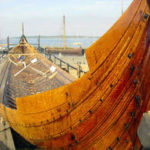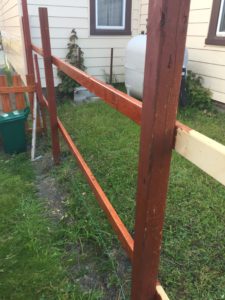Views: 248
For those who don’t mind spending extra on using the best, I offer a premium service of applying Organic Linseed Oil Paint (from Sweden). It is the only true oil paint available today. Protect, nourish and never scrape again; it will easily last 50+ years on exterior surfaces with a regular maintenance of just a coat of organic linseed oil every 5 or 10 years or more (depending on the amount of exposure to the elements). It will never peel or crack or cause wood to rot; paint failure is basically impossible. It is based on paint technology that has been used in Scandinavia since the 18th century. Initially, only valuable buildings like churches and mansions were painted with linseed oil paint. The future of paint is found in the past!
Organic linseed oil paint is made from cold pressed purified linseed oil and natural earth pigments and is the only real environmentally safe paint on the market today.
Note: Do not use on any surface that will be touched or walked on regularly such as decks or furniture. Because it never dries hard, it will rub off onto clothes or footwear.
- There is never any paint to dispose of. Any left over paint can be mixed into one can and used as a base coat on future projects.
- It is not sensitive to freezing or hot weather when stored. It can be applied in direct sunlight; actually, the warmer the wood is, the better. The best results are achieved on warm or hot days; ideally above 20°C because the oil paint is able to soak in much better the warmer the wood is.
- It covers twice the surface area compared to any acrylic petroleum based paints you find in a paint store because it does not contain any form of solvent. Organic linseed oil paint is 100% dry weight; acrylic petroleum paints are 40% dry weight. *Dry weight percentage indicates how much is left after the liquid paint is dry.
- Organic linseed oil paint will provide you with an exponential savings over time because it will never peel, crack or trap moisture that will cause wood to rot.
- It sticks to any dry, clean surface other than wood, such as plastic, steel, aluminum, old paint, etc…
- Organic linseed oil paint is very easy to maintain, by simply applying just a coat of organic linseed oil every 5-10 or even 15 years – depending on the amount of exposure to the elements. If for any reason the organic linseed oil paint is left untouched for 20 – 25 years, you will see the pigment become dry and starting to fall off. By brushing off the loose pigment, you can simply apply a new coat of organic linseed oil paint and you are ready to go for another generation or two.
- Organic linseed oil paint is a natural rust inhibitor. A great solution for any exterior steel structures.
- Documented by the Swedish Heritage board since 1982.
- Emissions tested and approved by the Swedish National Heritage Board and Environment Evaluation of Building Products. it has a ‘Green Arrow’ in the building material assessment. According to the Swedish National Heritage Board’s statement from 2003, solvent-free linseed oil paints are recommended in building conservation.
“A paint that wears out in a year no matter how little is costs is not cheap, it is dear.”
Some inspiring references of where Organic Linseed Oil Paint has been used are – Chateau du Versailles (France) – Amalienborg Palace, Copenhagen (Denmark) – Charlotte Berlins Museum, Ystad, (Sweden) – Masonic Lodge, Oslo, (Norway) – Holkham Estate (England) – Canadian Parliament Buildings (west block) – Strathmore House (Cobourg) – Dundurn Castle, (Hamilton) – Spading Stables, (Toronto) and many other heritage buildings in Europe and North America.
Genuine Pine Tar

This is ‘The Finest Stuff – 100% organic – authentic pine tar is also referred to as Stockholm tar, is a pure natural wood preservative made in Sweden. Pine Tar has been used since ancient times for creating a water repellant barrier on wood and ropes. Genuine pine tar is an ideal wood preservative for wood used underground, such as utility poles or fence posts and also perfect for decks, cottages and out buildings, etc… It’s an excellent alternative to pressure treated wood.
- The Swedish Cultural Management recommends Pine Tar as surface treatment of wooden church roofs and other cultural buildings made of wood.
- There are examples of stave churches that have been preserved with Pine Tar for nearly a thousand years with very few intervals of maintenance.
Pine Tar Stain is a very old Swedish tradition for the surface treatment of wooden buildings and outdoor wooden structures. It is exceptional protection for wood in damp or humid climates like here in Newfoundland.
Lifetime fence – I am hoping this will be the last time I will ever have to fix this fence in my lifetime. The posts of the previous fence rotted and it fell over. So, my plan was to build a fence that will survive the test of time using linseed oil and pine tar products.
I treated the fence posts with red pine tar before being set in concrete. Then the holes were topped with gravel around the posts. I painted the stringers with the same red pine tar as well. After the pine tar had dried well, I stained the posts and stringers with linseed oil wax stain mainly for aesthetic reasons. They were well preserved with just the pine tar but waxing after will certainly add another layer protection


To give it a custom look, I used 3 different sized palings with 3 different colours of linseed oil wax stain. I used Mahogany and Red coloured stain with a black accent 2″x2″ paling roughly 1/2 way between the posts. The palings were stained and laid inside to dry for a few days first before nailing on with ‘stainless steel ribbed nails’. Nail heads to be touched up with stain.






House painting philosophy
Here is an intriguing excerpt from a book on painting , written 100 years ago but is certainly still relevant and essential today as it was then.
On the philosophy of house painting: House painting is undertaken for three principle reasons:
The first is for ‘preservation’
The second is for ‘cleanliness’
The third is for ‘beautification’
General – These three principle reasons are placed in the above order because the quality of cleanliness is of greater importance to the community* than that of beauty; and further because the first necessarily provides the reason for the very existence of the craft. In addition to these reasons, the fact is also apparent, that it is not possible to have a complete and true beauty if the first two qualities are absent.
With ‘preservation’ being the ultimate first principle of painting and the very reason for the existence of the craft, it stands to reason that ‘organic linseed oil paint’ and its family of products are the only true preservation products available today that meet the first principle criteria.